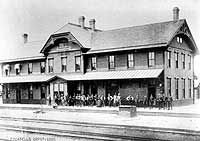|
Page
58
|
Construction
of the Oregon Short Line
Oregon Short Line
began construction of its standard-gauge line shortly after the road was organized
in 1881. In Idaho, the roadbed was built in both directions from Pocatello but
track was laid from east to west. By early summer in 1882, construction gangs
from the Utah & Northern had built the roadbed past American Falls out into
the desert north of the Snake River and a major broad-gauge bridge over the
Snake was being finished. Because U & N crews had only narrow-gauge equipment,
the tracks were at first narrow-gauge, but after Oregon Short Line track-laying
crews arrived, the gauge was widened.
By the end of 1882, the tracks had reached Shoshone, where progress halted while the first branch line in Idaho was constructed north to Hailey to access the booming silver, lead, and zinc mines.
Oregon Short Line continued building west in 1883, and by November, 1884, crossed the new bridge over the Snake River at Huntington, Oregon, to connect Idaho and the east with Oregon and the Pacific slope. Rail service brought considerable growth and prosperity to Idaho leading to statehood on July 3, 1890.
Communities which the rails bypassed often closed doors and moved to the new line, except Boise City. To the great consternation of capital residents, Oregon Short Line followed a route 20 miles to the west, because to build into Boise would have involved a steep grade which the railroad wished to avoid. Instead, it built a branch from Nampa to Boise, not at all satisfying residents of what was then Idaho's 4th largest city (behind Rexburg, Moscow and Pocatello). This situation was not "corrected" until 1925.
Realignment of Right of
Way in the Portneuf Canyon
Utah & Northern
had discovered that from Oneida, as Arimo was known then, to Blackrock, west
of Inkom, the water table of Marsh Creek was so high that frequent flooding
interfered with train operations. It was decided in 1882 to shift the right
of way to higher ground and to utilize the new Oregon Short Line roadbed from
McCammon to Pocatello. A three track configuration resulted. Broad, or standard
gauge, was fixed by law at 4 feet 8 1/2 inches; the narrow-gauge utilized by
Utah & Northern was 3 feet wide, so standard-gauge trains used the two outer
rails while the narrow-gauge ran on the interior rail and one outer rail. This
configuration was extended to Pocatello and through out the yards there and
the original narrow-gauge line through the east side of what later became Pocatello
was abandoned.
 |
| Pacific Hotel and Passenger Station between the tracks in Pocatello, looking northeast, in the 1880s. Telegraph, railway agency and waiting room are on the right (south) end of building. Waitresses, maids, and other hotel employees are assembled on the station platform. The dining room was at the far (north) end. The Pacific Hotel was built in 1883 and the Mansard Roof was added in about 1887. The track has 3 rails, indicating that both narrow- and broad-gauge trains stopped here. This was true until 1890. Clifford Peake collection, Bannock County Historical Society. |
 |
| The Oregon Short Line freight depot in Pocatello, looking northeast, 1885. This structure was north of the Pacific Hotel, also between the tracks. The men standing in front of the station are probably railroad office workers. The Oregon Short Line offices were in this building. Note the three rail arrangement to accommodate narrow- and standard-gauge trains. Bannock County Historical Society Collection. |
The Ramsey Transfer and
the Widening of the Narrow Gauge
Having two different
gauges of track utilize the same facilities created operating problems. To avoid
having to physically transfer the ladings between cars of the different gauges,
a device was constructed at Pocatello known as the Ramsey Transfer where incoming
cars of either gauge were jacked up and wheels of the other gauge put under
the cars. While this speeded up the process of transferring freight between
the gauges, it was still necessary to keep a large force of workers to transload
freight between cars.
The difference in gauges created a bottleneck in the growing freight business. Most of the freight destined for Montana came into Pocatello on the broad-gauge Oregon Short Line and southbound freight from Montana went out on the broad-gauge. The gauge from Pocatello to Butte was widened on July 25, 1887, although the accepted version of the story (beal, 1957; 1980) has the widening taking place on Sunday, July 24, 1887 (Pioneer Day).
A Blackfoot, Idaho Newspaper, The Idaho News, in its July 30, 1887 edition carries an account by a reporter who boarded the first train over the new broad-gauge road, in company with Superintendent Robert Blickensderfer and many other railroad officials. Engineer G. Orum was at the throttle. Everything had been made ready for the change and at first dawn on Monday, July 25th, the signal was given and track crews began to re-lay the tracks. So as to avoid interrupting service as much as possible, extra crews had been brought in from the Oregon Short Line and the southern division of Utah & Northern. No mention is made in the newspaper account of any private citizens being used or of anyone being paid extra for the work.
Work was completed before the end of the day and only one train was delayed. The entire 245 mile road from Pocatello to Silver Bow, Montana, a few miles west of Butte, had been widened to standard-gauge. Utah & Northern went into Butte over leased track which did not require widening.
The narrow-gauge tracks to the south were not widened until 1890, when a new alignment through Cache Valley permitted the entire road to be standard-gauge. With this change, Preston became the end of the Cache Valley Branch and the main line passed along the west side of Cache Valley and down the Bear River canyon at Cutler Narrows to Brigham City.